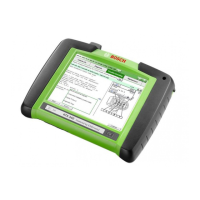WLAN (Wireless Local Area Network)2.6
The WLAN function is to be activated at a later date. i
Important information on WLAN2.6.1
The Wireless Local Area Network (WLAN) provides a
radio link on the free 2.4 GHz ISM band (ISM: Industri-
al, Scientific, Medical). This frequency range is not sub-
ject to state legislation and can be used in most coun-
tries without a licence (for exceptions, refer to Section
2.5). Consequently a large number of applications and
devices employ this frequency band for transmission.
This can result in frequency interference.
Depending on ambient conditions, the WLAN link may
therefore deteriorate, e. g. in the case of Bluetooth
links, cordless telephones, radio-controlled thermom-
eters, radio-controlled garage door openers, radio-con-
trolled light switches or radio-controlled alarm systems.
Bluetooth can cause bandwidth collapse in the i
WLAN network. The antennas of Bluetooth and WLAN
devices should be at least 30 centimeters apart.
Bluetooth USB adapters and WLAN sticks are not to
be plugged into adjacent PC/Laptop USB slots. Use
the USB extension cable (special accessory) to main-
tain a distance between the Bluetooth USB adapter
and the WLAN stick at the PC/Laptop.
Extreme caution is to be taken if wearing pace- i
makers or other vital electronic devices when using
radio systems, as proper functioning of these items
could be impaired.
Pay attention to the following to ensure the best pos-
sible connection:
The WLAN radio signal always tries to find the most R
direct path. When setting up the PC/Laptop and ac-
cess point (refer to Section 2.6.2), make sure there
are as few obstacles as possible (e. g. steel doors and
concrete walls) which could interfere with the radio
signal from and to the KTS 340.
Inside buildings, the range of the WLAN is also greatly
influenced by the construction materials used. Conven-
tional masonry, wooden walls and certain types of dry
construction wall scarcely impede radio waves. Thin
gypsum walls can however cause problems, as con-
siderable amounts of moisture may accumulate in the
gypsum and result in the absorption of radio signals.
Concrete (and in particular reinforced concrete) largely
blocks out radio waves. Cellar ceilings are often impen-
etrable. Generally speaking, walls with a lot of installed
metal (e.g. pipes, wires) obstruct radio waves.
Radio reception is also impeded by large metal R
objects such as radiators and window frames
as well as active sources of interference such as
DECT telephones and microwave ovens.
Have your network infrastructure installed and R
tested in advance by a data systems expert.
Keep the SSID and the codes for the radio link in a R
safe place. Make sure these data are readily to hand
in case faults occur.
We recommend a thorough inspection of the premis- R
es on commissioning: Establish where in the building
the KTS 340 works properly and where the operating
limits are.
The radio link is affected by weather conditions. The R
reception signal may therefore vary.
Please contact your network administrator with any R
queries.
Notes on access point2.6.2
A wireless access point is an electronic device which
acts as an interface between a radio network and a
cable-connected computer network. It provides a wire-
less connection between the KTS 340, the PC/Laptop
and a printer for example.
Heed the following:
The access point should be located as centrally and R
high up as possible, ideally under the ceiling.
The access point antenna should face downwards R
towards the floor.
In the event of a poor connection it may be useful to R
change the channel set on the access point.
Notes on WLAN for USA and Canada2.6.3
USA:
Changes or modifications not expressly approved by
the party responsible for compliance could void the
user’s authority to operate the equipment.
Kanada:
Operation is subject to the following two conditions:
this device may not cause interference, and R
this device must accept any interference, including R
interference that may cause undesired operation of
the device.
L'utilisation de ce dispositif est autorisée seulement
aux deux conditions suivantes :
il ne doit pas produire de brouillage, et R
l'utilisateur du dispositif doit être prêt à accepter R
tout brouillage radioélectrique reçu, même si ce
brouillage est susceptible de compromettre le foncti-
onnement du dispositif.
This Class [B] digital apparatus complies with Canadian
ICES-003.
Cet appareil numérique de la classe [B] est conforme à
la norme NMB-003 du Canada.

